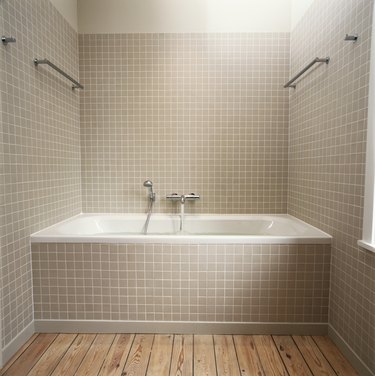
If you don't have an access panel behind the tub and shower when problems arise, you'll wish you did. Without it, the only way to fix the plumbing is to cut a hole in the wall. If the wall is tiled, and you have a plumber, you'll be paying him to make a big mess in the bathroom. Despite this, the lack of an access panel is not a code violation in most circumstances.
Tub and Shower Plumbing
Video of the Day
Most modern tub and shower valves can fail, but even so, once they are properly soldered to the water pipes, the plumbing code allows you to cover them. An exception is when the valve has an extra mechanism, such as a water pressure regulator, that you can adjust. In that case, you must provide a removable access door. If you have such a device that isn't part of the tub and shower valve proper, then the door must provide access to the device. This requirement applies to auxiliary shut-off valves. They must remain accessible no matter where you install them.
Video of the Day
Other Special Circumstances
In general, you don't have to provide access to drain plumbing, and although some older houses have access panels to access the drain pipes behind the bathtub, many newer ones don't. Drain clean-outs are the only exception to this rule; they must remain accessible, or they can't serve their purpose. One more exception exists in regard to water supply pipes. If you use a compression fitting, either to install a valve or make a repair, that fitting must remain accessible so that if it fails, you can fix it. Moreover, if your bathtub includes a motor or auxiliary heater, you need a panel to access it.
Placing the Tub/Shower Panel
Even though it isn't required, it's a good idea to have an access panel behind the tub and shower. If a wall separates the tub from the toilet or another part of the bathroom, then the outside of that wall provides an ideal location for a panel. If the bathroom doesn't feature such a wall, an alternative is to build a panel into the closet in an adjoining room. One advantage of putting the panel in a closet is that you can oversize it to give yourself plenty of room to work should repairs become necessary.
Considerations
If you're building or remodeling, and need to install plumbing devices or fittings that require a panel, it's best to put them all behind a single access panel. You can use the need for the panel to help in the placement of needed storage space, because the panel is invisible if it forms the back wall of a closet. The closet could be behind the tub and shower; this way, the panel could be large enough to give you access to both the tub/shower water and drain pipes, adjustable regulators and valves, and electrical equipment for the jacuzzi.